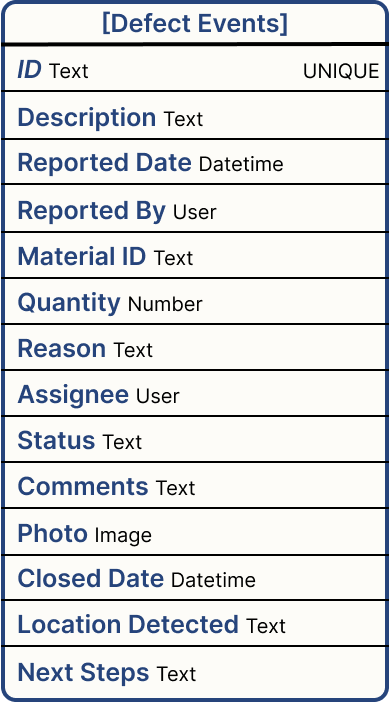概述
正确的数据架构是推动正确行动以改进流程的关键。数据从来都不是万能的,因为要解决的问题很少是相同的。本 Functional Example} 概述了建议用于缺陷跟踪的核心数据。欢迎添加更多 Field 来扩展此功能示例。
扩展概念文档将介绍在此数据模型基础上构建数据模型的一些方法,以实现更高的价值。
表格
本应用依赖表格来存储数据。之所以推荐使用表格(而不是 Completions),是因为这意味着同一个表格可以在多个应用程序中使用,这是 Composability 的一个关键特性,尤其是在缺陷跟踪跨越多个应用程序的情况下。
本应用依赖于单个[缺陷事件]表。
扩展概念》涵盖了扩展此数据模型的一些机会,包括与订单跟踪或其他用例进行更广泛的互联。
[缺陷事件]表

缺陷事件表是推动流程可见性所需的基本数据。某些表记录字段是可选的,而其他字段则是保持操作可见性所必需的。
请记住,这些字段不一定需要由专人填写。订单信息可以来自外部数据源,也可以根据条件逻辑推断。
例如通过将材料变量和原因变量与表达式相结合,自动计算出缺陷描述:
缺陷 ' + @Variable.Material + ' 由于 ' + @Variable.Reason
表 Field}s
ID(文本)--所有表都需要一个 ID 列来唯一表示每个表记录。在本例中,我们使用随机字符串作为记录 ID。
描述(文本)-- 缺陷的可读描述。在 Functional Example} 中,格式为 "DefectedMaterialdue toReason(原因导致的缺陷材料)"。
报告日期(日期时间)- 缺陷最初报告的时间。
报告人(用户)-报告缺陷的用户。在功能示例中,该值由登录用户填充,但也可设置为静态用户,或允许用户选择报告者。
材料 ID(文本)- 发现缺陷的材料 ID。将此字段替换为[材料]表的链接记录将是 扩展概念的好方法。
数量(数字)- 顾名思义,这是缺陷部件的数量。
原因(文本)- 与 "状态"字段类似,"原因 "字段可用于将缺陷自动发送到正确的团队。
例如所有多余库存缺陷都应由生产经理处理
受让人(用户)- 负责处理缺陷的用户。可根据 "原因 "动态设置,或静态设置为单个用户/团队
状态(文本)- 该缺陷的当前状态。当缺陷在 Functional Example 中报告时,默认状态为 "新"。在我们的使用案例中,缺陷会经历 3 种状态: 1.新 2.审查中 3.已关闭
注释(文本)--一个自由格式的文本字段,可收集有关缺陷的任何注释。利用此字段作为根本原因分析的一部分。结合 Digital Record History 小工具,您可以查看每个缺陷的历史数据。
照片(图像)--收集缺陷的照片。利用图片可以更好地了解根本原因。
关闭日期(日期时间)- 缺陷解决后,此字段可跟踪缺陷报告的关闭日期。在分析中利用该字段可了解现有未结缺陷报告的积压情况。
检测到的位置(文本)- 按照首次发现缺陷的位置对缺陷进行排序。利用该字段可深入了解流程中最常见的故障点。此外,还可利用此字段将缺陷分配给正确的受让人。
Next Stes(文本)- 跟踪缺陷的解决情况,当与 Digital Record History 结合使用时,用户可以看到缺陷是如何解决的。小工具相结合时,用户可以查看缺陷的解决情况。

.gif)